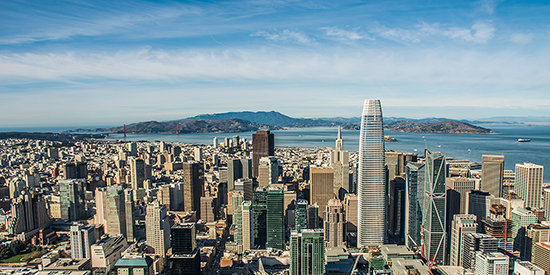|
Subscribe / Renew |
|
|
Contact Us |
|
| ► Subscribe to our Free Weekly Newsletter | |
| home | Welcome, sign in or click here to subscribe. | login |
Construction
| |
 |
January 22, 2019
National finalist: Platinum award
Structural systems
Magnusson Klemencic Associates

Project: Salesforce Tower
Client: Boston Properties/Hines
From the first-of-its-kind foundation system that reaches more than 300 feet into the ground to its whimsical public art “lantern” 61 stories up, the 1.4 million-square-foot Salesforce Tower has transformed San Francisco’s skyline and has been called the centerpiece of the city’s new Transbay District.
The 1,070-foot-tall building’s high-performance core, designed by Magnusson Klemencic Associates, is one of its crowning jewels. It required extensive proof-of-concept and the approval of an independent structural peer review panel to allow its use beyond the prescriptive provisions of the building code.
The “core only” system works without the aid of any contribution from the exterior structural system to resist winds and earthquakes. The concrete reinforcing steel was sized and distributed in the walls based on the predicted demands of 22 actual earthquake records applied to the computer model of the core, rather than the standard simplified earthquake model used by the prescriptive method of the code.
Not only does this core deliver a 40 percent increase in seismic safety compared with other office buildings in San Francisco, it also eliminates all the requirements for closely spaced exterior columns, exterior bracing systems, damping systems, and “outrigger” or “belt” systems that tie the exterior structure to the core. As a result, the space and daylighting inside the building is greatly increased.
Because of its location just eight miles from the San Andreas Fault and 10 miles from the Hayward Fault — and atop almost 250 feet of soil deposits that would typically be too soft for a building of this size — the tower required a robust foundation system. The result: a system that is the deepest in the city and one of the deepest ever built in the U.S.
The 42 cast-in-place concrete foundations, or load-bearing elements (LBEs), are as deep as 310 feet, then drilled an additional 10 to 70 feet into the bedrock until satisfactory support was obtained. The high-capacity LBEs are connected with a 14-foot-thick concrete mat foundation, which provides a robust base for the superstructure.
The Salesforce Tower project took seismic analysis to the next level with an expanded application of already-robust soil-structure interaction analysis technology.
Most advanced projects use computer modeling to analyze how horizontal forces interact with the motion of both the soil and the structure as a system. For Salesforce Tower, the modeling was expanded to include not only the structure and soil but also the structures of several surrounding buildings.
This was important because the very weak soils in the area and the tower’s close proximity to the under-construction Salesforce Transit Center could cause the buildings to bang against each other below grade. The analysis identified some areas where the tower and transit center might interact, creating some areas of unusual stress. Additional reinforcement was added in certain areas to eliminate that possibility.
The owner and the architect wanted a 150-foot-tall tower-top crown, illuminated with 11,000 LED lights for public art. This massive, 12-story installation was designed by artist James Campbell and reflects abstract scenes from around the Bay Area, transforming the night skyline with an animated dance.
The “canvas” for this art required a sophisticated structure to provide the necessary resistance to wind and earthquake loads and support building maintenance units, but at the same time minimize shadow casts on the city below. Through careful selection of materials, designers achieved a porosity of 41 percent.
The LEED platinum-certified project is owned by Boston Properties and Hines, with architecture by Pelli Clarke Pelli and Kendall/Heaton Associates.
Other Stories:
- National finalist: Gold award
Structural systems
BergerABAM - Best in state: Gold award
Complexity
Reid Middleton - Best in state: Gold award
Unique or innovative applications
Stantec Consulting Services - Best in state: Gold award
Future value to engineering profession
Landau Associates - Best in state: Gold award
Successful fulfillment of client/owner needs
Golder Associates - Best in state: Gold award
Successful fulfillment of client/owner needs
Cary Kopczynski & Co. - National finalist: Gold award
Transportation
WSP - National finalist: Gold award
Structural systems
HDR/Shannon & Wilson - National finalist: Gold award
Special projects
David Evans and Associates - Engineer of the Year


